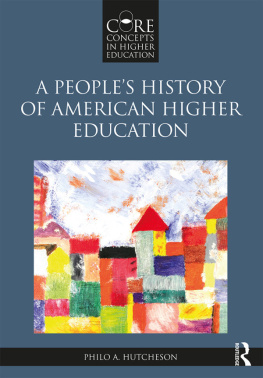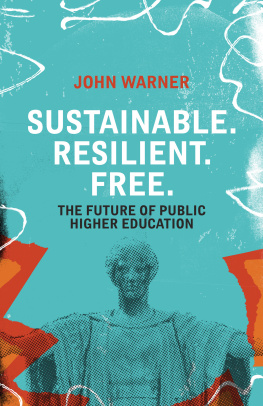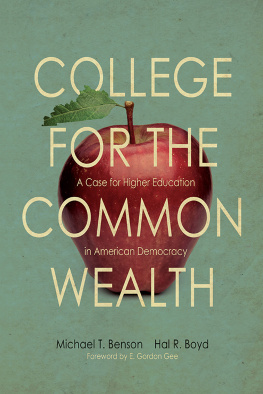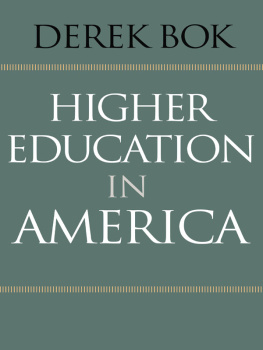Higher Education and Silicon Valley
HIGHER EDUCATION
SILICON VALLEY
Connected but Conflicted
W. RICHARD SCOTT,
MICHAEL W. KIRST,
COLLEAGUES
Johns Hopkins University Press
BALTIMORE
2017 Johns Hopkins University Press
All rights reserved. Published 2017
Printed in the United States of America on acid-free paper
9 8 7 6 5 4 3 2 1
Johns Hopkins University Press
2715 North Charles Street
Baltimore, Maryland 21218-4363
www.press.jhu.edu
Library of Congress Cataloging-in-Publication Data
Names: Scott, W. Richard, author. | Kirst, Michael W., author.
Title: Higher education and Silicon Valley : connected but conflicted / W. Richard Scott, Michael W. Kirst, and Colleagues.
Description: Baltimore : Johns Hopkins University Press, 2017. | Includes bibliographical references and index.
Identifiers: LCCN 2016046943| ISBN 9781421423081 (pbk. : alk. paper) | ISBN 1421423081 (pbk. : alk. paper) | ISBN 9781421423098 (electronic) | ISBN 142142309X (electronic)
Subjects: LCSH: High technology and educationCaliforniaSan Francisco Bay Area. | High technology industriesEmployeesTraining ofCaliforniaSan Francisco Bay Area. | Business and educationCaliforniaSan Francisco Bay Area. | Education, HigherEconomic aspectsCaliforniaSan Francisco Bay Area.
Classification: LCC LC1087.3.C2 S36 2017 | DDC 378.1/035097946dc23
LC record available at https://lccn.loc.gov/2016046943
A catalog record for this book is available from the British Library.
Special discounts are available for bulk purchases of this book. For more information, please contact Special Sales at 410-516-6936 or specialsales@press.jhu.edu.
Johns Hopkins University Press uses environmentally friendly book materials, including recycled text paper that is composed of at least 30 percent post-consumer waste, whenever possible.
Contents
W. Richard Scott, Michael W. Kirst, Manuelito Biag, and Laurel Sipes
W. Richard Scott, Brian Holzman, Ethan Ris, and Manuelito Biag
W. Richard Scott, Bernardo Lara, Manuelito Biag, Ethan Ris, and Judy C. Liang
W. Richard Scott, Manuelito Biag, Bernardo Lara, and Judy C. Liang
W. Richard Scott, Ethan Ris, Manuelito Biag, and Bernardo Lara
W. Richard Scott, Ethan Ris, Judy C. Liang, and Manuelito Biag
Michael W. Kirst, Anne Podolsky, Laurel Sipes, and W. Richard Scott
Brian Holzman
Preface
The eyes of the world are on the San Francisco Bay Area. Much of the attention is focused on the regions economy, trying to understand and replicate a remarkable success story in the information technology sector. The world, however, is also closely watching the Bay Areas higher education field. Hewlett-Packard, Cisco, Apple, and Google are not the same types of manufacturing or service giants that dominated previous economic booms in the United States; their dynamics are driven by intellectual capital, which requires high levels of skills and training.
While the technology sector and higher education are similar in some ways and interdependent, they are also mismatched in several important respects. The two fields developed under differing conditions, have been responsive to different constraints and incentives, and differ substantially in their pace of change. The institutions of higher education in this country developed in the latter part of the nineteenth century and adopted a bureaucratic structure that provided discretion to academic professionals. The ends served are intangible and remote. In contrast, the structure of new industries is made up of multiple, flexible organizations adapted to respond rapidly to changes in market opportunities and demands. To understand the interactions between the Bay Areas higher education providers and the Silicon Valley economy, it is essential to view these organizations within the context of their differing fields.
Unlike many other accounts linking higher education and hi-tech industries, our approach is not restricted to the role of the research universities such as Stanford and the University of California, Berkeley, although they are of obvious importance. Rather, we consider the full range of academic institutions, focusing especially on broad-access colleges, like the comprehensive state colleges, nonprofit and for-profit colleges, and community colleges that enroll the great bulk of students.
By incorporating broad-access colleges in the conversation, we have found a more complex ecology that holds implications for regions that lack monolithic ivory towers. Broad-access colleges may not create breakthrough technologies, but they do provide vital human resources to sustain the development of industry. These institutions have been frequently overenrolled and underfunded, and subjected to financial and administrative constraints that prevent them from fully responding to the needs of regional and national economies. They warrant attention now more than ever.
Our study comes in the context of increased pressure on colleges and universities to offer more programs featuring career and vocational training. Institutions are responding both to the expressed desires of their clients and to a clamor from national, state, and regional interests demanding that higher education do more to stimulate economic development and provide workforce training. This impetus is not new, but it has become more intense in recent decades. More importantly, because of the huge variety among types of colleges and variation in local conditions, there exists increasing variability both in the kind of economic and political pressures being exerted and in the strategies pursued by colleges in responding to them.
It is impossible to understand developments occurring within higher education in our time without attending to changes in the ecology of the organizations providing these services. The nature and types of colleges are changing, as is the constellation of the support and control systems they confront. To accommodate this variety, this book takes a longitudinal approach, integrating data from interviews, statistical analysis, and document analysis that cover more than 45 years, beginning in 1970. Our aim is to chronicle changes in the types of colleges operating in the Bay Area during this time frame, as well as changes over time in the numbers and types of hi-tech employers. We also examine internal changes in colleges occurring during this period in the types of faculty employed, the academic programs offered, and the types of graduates who emerged. Throughout, we endeavor to address the effects of the larger historical context, including policy decisions at federal and state levels, administrative structures, and reactions from faculty and students, on the events and trends that we describe.
Additionally, although the Bay Area is geographically compact, we found addressing it as a single entity was misleading. At times throughout the book, we break down the larger Bay Area into three sub-regions, each of which has its own unique ecology of industry and higher education, as well as its own unique demographic patterns. This sub-regional approach helps us to explore in more detail who what types of collegesadapted in an attempt to meet the changing needs of local employersand how what strategies and tactics colleges employed to adapt to industry demands. We also take care to include different institutional forms in our examination of sub-regions, paying close attention to public institutions (both two-year and four-year), private nonprofits, and for-profits in each area.
The end result, we hope, is a book that is relevant for anyone engaged in the broad enterprise of higher education including administrators, educators, academic researchers, and students, as well as those working in professional associations and public and private oversight bodies. Our intended audience includes business leaders, human resource staff, planners, and economic geographers interested in understanding and improving the interface between schools, training, and work. Students and scholars in the areas of higher education, organizational sociology, and regional economics will find much of interest here. Finally, policy makers at all levels may find this book a stimulating repository of lessons about the ways in which higher education institutions and industry can collaborateor why they fail to do so.
Next page





